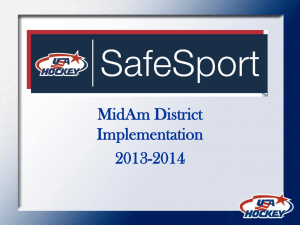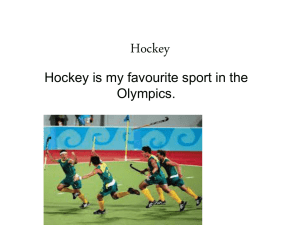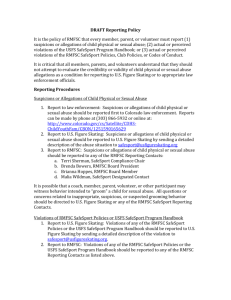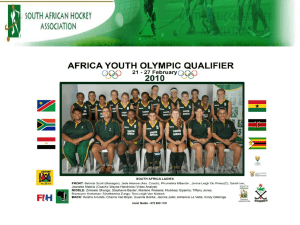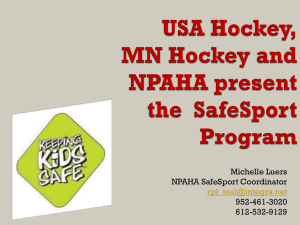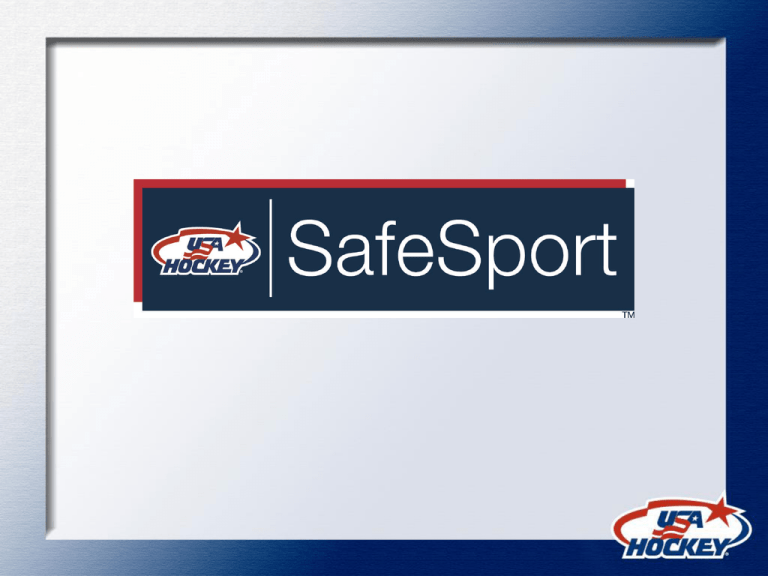
SafeSport Task Force:
Dave Ogrean (chair), Pete Lindberg, Dennis
Green, Steve Laing, Casey Jorgensen, Rae
Briggle, Kevin McLaughlin, Bob Weldon
SafeSport Program Development
• 2011 – USOC begins work on SafeSport Program Handbook
• January, 2012 – President Ron DeGregorio announced task force to report on how best to
protect USA Hockey’s participants in all aspects of the sport
• Spring, 2012 -- SafeSport Task Force began work on evaluating existing programs and
recommendation to USA Hockey Board of Directors for a comprehensive program.
• June, 2012 – USA Hockey Councils, Committees and Sections reviewed recommendations of
SafeSport Task Force and Board of Directors establish USA Hockey SafeSport Program.
• September, 2012 – SafeSport Handbook completed
‒ SafeSport website live on www.usahockey.com/SafeSport
‒ Reporting by phone, email and website available
‒ SafeSport Program Posters sent to all arenas and programs
• December, 2012 – USOC to consider SafeSport compliance when evaluating funding and
NGB status.
• January, 2013 – Report to USA Hockey Board of Directors on program to date and evaluate
recommendations for any modifications.
• April, 2013 -- USOC Online Training Available (interim platform)
Screen grab of webpage
Why SafeSport?
• To protect our participants by creating an environment
that puts the potential offender at risk.
• To prevent known offenders from joining our program and
deter offenders that have not yet been caught.
• To protect the reputations of USA Hockey, its Affiliates and
local programs as organizations that are safe from abuse.
• To prevent negligence and help insulate USA Hockey, its
affiliates, local programs and volunteers from liability.
Policies Prohibiting Abuse
• Policies that set boundaries for appropriate and
inappropriate conduct
Sexual Abuse
Physical Abuse
Emotional Abuse
Bullying, Threats, and Harassment
Hazing
Managing Hockey Environments
• Policies to reduce the risks for potential abuse
Locker Room Policy
Electronic Communications Policy
Travel Policy
Billeting Policy
Sexual Abuse Policy
• Prohibits sexual abuse of any participant
• Sexual contact between children can be abusive if
significant disparity in age, development or size
• Neither consent of minor, mistake as to age, nor fact that
contact occurred outside of hockey are defenses to a
complaint
• Sexual abuse may also occur between adults if
nonconsensual, coerced or manipulated
• May include “non-touching” offenses, such as sexual
harassment, sending nude pictures, sexually explicit
emails, exposing minors to pornography, etc.
Physical Abuse Policy
• Prohibits physical abuse of any participant in our programs
• Includes physical contact that causes or has potential to
cause harm, or creates the threat of bodily harm
• Includes throwing or threatening to throw objects or
sports equipment
• Also includes providing alcohol to a minor participant, or
providing drugs to any participant
• Physical abuse does not include physical contact that is
reasonably designed to coach, teach, demonstrate or
improve a hockey skill, including physical conditioning,
team building and appropriate discipline
Emotional Abuse Policy
• Involves a pattern of deliberate, non-contact behavior that has
the potential to cause emotional or psychological harm to a
participant
• May be verbal acts, physical acts or acts that deny attention or
support
• Examples include a pattern of verbal abuse or physically
aggressive behaviors, such as throwing equipment, water
bottles, or chairs, or punching walls, windows, or other objects.
• Does not include generally-accepted and age appropriate
coaching methods of skill enhancement, physical conditioning,
motivation, team building, appropriate discipline, or improving
athletic performance.
Bullying, Threats & Harassment Policy
• Bullying – Involves a pattern of physical or non-physical behaviors
intended to cause, fear, humiliation or harm in an attempt to exclude,
diminish or isolate another person
– Includes written, verbal or Cyber-bullying
• Threats – Involves any written, verbal, physical or electronically
transmitted expression of intent to harm
• Harassment – Involves a pattern of physical/non-physical behaviors:
Intended to cause fear, humiliation or annoyance
Offend or degrade
Create hostile environment
Reflect discriminatory bias
– Includes Sexual Harassment
– Examples include (a) comments about a participant’s sexual orientation,
gender expression, disability, religion, skin color, or ethnic traits; (b)
displaying offensive materials, gestures, or symbols; and (c) withholding or
reducing playing time based on sexual orientation.
• Coaches and other adults cannot ignore and must intervene
Hazing Policy
•
Includes any conduct which is intimidating, humiliating, offensive, or physically
harmful
•
Hazing is typically an activity that serves as a condition for joining a group or
being socially accepted by a group
•
Examples include requiring or forcing the consumption of alcohol or drugs;
physical restraint; sexual simulations/acts; social actions (e.g. grossly
inappropriate or provocative clothing) or public displays (e.g. public nudity);
beating, paddling, or other forms of physical assault.
•
“Locker Boxing” is also a form of hazing
•
A person’s consent to participation does not mean it is not hazing
•
Hazing does not include group or team activities that are meant to establish
normative team behaviors, or promote team cohesion, so long as they do not
have reasonable potential to cause emotional or physical distress
•
Coaches and other adults cannot ignore and must intervene
Locker Room Policy
•
Locker room supervision is one of the most critical elements to reducing risk
of abuse or misconduct
•
Requires at least one properly screened adult
•
At lower age groups, numerous adults may be present
•
Team may prohibit parents in locker room (subject to common sense)
•
No adult should be alone with minor participants
•
Cell phones and recording devices/cameras may not be used in the locker room
•
Each local program shall publish their specific locker room policy
•
Coach and team administrators are responsible for compliance with locker
room supervision requirements
•
With Co-Ed teams both female and male privacy rights must be given
consideration and appropriate arrangements made. It is not acceptable for
persons to be observing the opposite gender while they dress or undress
Electronic Communications Policy
•
Communications involving participants should be appropriate, productive, and
transparent
•
Use of various forms of electronic communications increases the possibility for
improprieties and misunderstandings and also provides potential offenders
with unsupervised and potentially inappropriate access to participants.
•
Any content of an electronic communication should be readily available to
share with the public or families of the player or coach. If the player is under
the age of 18, any email, text, social media, or similar communication must also
copy the player’s parents.
•
Social media should be used for communicating team activities, not personal
•
Electronic communications are often used to bully, threaten or harass other
participants
Travel Policy
•
Minor players are most vulnerable to abuse or misconduct during travel
•
Adherence to travel policies helps reduce opportunities for misconduct
•
Local travel should be the responsibility of the parents, not team
•
Coaches/volunteers should avoid driving alone with an unrelated minor
•
Coaches should never share a hotel room with an unrelated minor
•
Drivers should have driving records checked
•
Team should provide adequate supervision/chaperones
•
Hotel rooms should be monitored/checked regularly by screened adults
•
There should be cooperation with family regarding telephone calls, family in
same hotel, distribution of travel itineraries, etc.
•
No coach or chaperone shall be under influence of alcohol/drugs while
performing their duties
Billeting Policy
• Primarily exists at Junior and Tier I Midget level
• All adults in billet home must be screened
• Program should have published rules and regulations for the billeting
arrangement – agreed to by parents, billets and player
• Team as well as host family rules/curfews shall apply
• Team/Program should have a billet coordinator
Education and Awareness Training
•
Provides our members with information necessary to effectively monitor their
organization, minimize the opportunities for abuse and misconduct, and
respond to concerns
•
Awareness training available to all coaches, managers, employees and
volunteers at no cost
•
Training was produced by the United States Olympic Committee
•
A membership number is required, but those not registered with USA Hockey
may do so at no cost by registering as a manager/volunteer
•
SafeSport Policy requires training for those that:
Have routine access to or supervision over youth participants
Are responsible for enforcing child abuse and misconduct policies
Are in managerial or supervisory roles
Are employees or volunteers
•
At least one person from each program must complete training by 11/30
•
Affiliate is responsible for confirming and certifying compliance
•
USA Hockey to develop additional promotional and training pieces
Screening of Staff and Volunteers
•
Purposes of a Screening Policy:
Protect USA Hockey participants from known offenders by preventing their access
to USA Hockey members
Deter offenders that have not been caught from joining USA Hockey programs
because the program has a known policy against abuse
Protect USA Hockey’s reputation as a sport where participants are safe from abuse
Help protect USA Hockey, USA Hockey Member Programs and their respective
employees and volunteers from liability that could arise from allowing a previous
offender to have access to minor participants
•
•
•
•
•
Screens are valid for two (2) years
Affiliate manages the screening process within their Affiliate, and must submit
such process each year to USA Hockey
Screening company must perform a “national” screen
Must include identity verification process
USA Hockey includes minimum criteria that must be searched, as well as
additional criteria that could result in ineligibility
Screening, cont.
•
Screening is required for those that:
•
•
•
•
•
•
•
•
Have routine access to or supervision over youth participants
Are responsible for enforcing child abuse and misconduct policies
Are in managerial or supervisory roles
Are employees or volunteers
Screen must be completed prior to serving in that role
Member programs must comply in 2013-2014
Affiliate is responsible for confirming and certifying compliance by 8/31/13
Affiliates must report any volunteers that have been denied eligibility based on
the person not consenting to be screened or failing a screen
While screening only catches offenders that have a criminal record, a
comprehensive screening program demonstrates the program’s priorities
Potential offenders will look for places where they will not be caught
42% of red flags showed criminal activity in another state
When we allow a coach to hold a position, we are putting our stamp on them
that they are OK.
Reporting of Concerns of Abuse
•
An effective reporting policy that results in reports of suspected abuse and
misconduct, and does not in any way deter victims or witnesses from reporting
abuse and misconduct, is a key element to preventing abuse and misconduct
from occurring.
•
Potential abusers will avoid involvement in a program where there is a
likelihood that suspected abuse will be reported.
•
Reports to USA Hockey may be made by: (1) clicking on the “Report to USA
Hockey” link on the USA Hockey SafeSport Program webpage, (2) emailing to
SafeSport@usahockey.org, or (3) calling 800-888-4656.
•
Reports may also be made to Affiliate SafeSport Coordinator
•
All cases involving suspicions or allegations of child physical or sexual abuse
must be reported to the appropriate law enforcement authorities
•
USA Hockey and its programs should not investigate or try to judge the
credibility of an allegation of suspected child physical or sexual abuse as a
condition of reporting to the authorities
Reporting, cont.
• Some people in our organizations may be mandatory reporters:
www.childwelfare.gov.
•
SafeSport Policy requires all USA Hockey employees and volunteers to
report violations of the SafeSport Program Handbook or Policies
• Immediate suspension or termination?
• Confidentiality/Anonymous Reporting
• Whistleblower protection when reports are made in good faith.
Complainants are protected from retaliation, punishment or
retribution.
• Malicious, frivolous or bad faith reports are grounds for disciplinary
action and/or civil or criminal action
• Reports to USA Hockey.
Responding to Reports of Abuse
• SafeSport does not create a new disciplinary program or system. It is
simply a collection of policies that regulate conduct, provide
mechanisms for members to report suspected abuse, and helps create
and environment that is hostile to potential abusers.
• Follow USA Hockey Bylaw 10
– Summary Suspensions
– Hearings
– Notifications
• When in doubt about the process, ask…
“In all cases, the disciplinary procedures and actions of USA Hockey and its
Affiliates and local programs shall be proportionate, reasonable and
applied fairly and equally.”
Monitoring and Supervision
The Monitoring and Supervision aspect of the SafeSport Program helps USA
Hockey and its Member Programs monitor, supervise and safeguard that the other
aspects of the SafeSport Program are being followed, and how they may be
improved, so that they result in a safe environment for the participants.
• Coaches – For his/her team, the coach is primarily responsible for monitoring
so that locker room, travel, electronic communications and behavioral policies
are being followed -- These duties may be delegated
• Local Programs – Must monitor program personnel so that they are enforcing
program policies, and so that all volunteers are screened and have received
proper training prior to serving
• Affiliate – Affiliate SafeSport Coordinator shall monitor compliance by local
programs. Shall monitor reports, investigations and disciplinary actions within
Affiliate. SafeSport Coordinator shall certify Affiliate’s compliance (to their
knowledge) to USA Hockey
• USA Hockey – Shall monitor Affiliate’s compliance, assist Affiliate’s with
investigations and provide guidance, shall enforce policies with national level
staff and volunteers, and shall maintain SafeSport Task Force.
SafeSport Next Steps
(anticipated)
•
•
•
•
•
•
Ongoing -- Adjustments to Program and Handbook
April, 2013 – USOC Stop the Abuse Compaign
April – May, 2013 – Training of SafeSport Coordinators
‒ Encourage training by local program leaders, USA
Hockey Board of Directors and Volunteers
‒ Encourage training for national tournament
participants
‒ Develop short video to be sent to all members
Summer, 2013 – USOC Online Training updated to new platform
August, 2013 – Emails to members regarding SafeSport Program & Training
2013-14 Season – Full implementation of Program
What Others are Saying…
•
•
•
•
Other NGB’s using Handbook as a sample.
Represented USA Hockey on panel at USOC’s best practices seminar.
Handbook used in seminar at John Jay College of Criminal Justice as an example of
best practices for institutions that have interaction between adults & adolescents.
From an Affiliate SafeSport Coordinator:
“BTW, I am now on our 6th complaint…. One byproduct that I doubt anyone thought of is
that when upset parents learn that myself and SafeSport exist, they are quite thankful
that this program is there for them. There is a palpable attitude amongst our
constituents that nobody really cares about their concerns and that the “good old boys”
will sweep the ugliness under the rug. I make it clear that although I AM NOT their
ombudsman, but I am a fair and impartial investigator that will insure that the matter is
fully looked into and ultimately resolved… in each case so far they have expressed
gratitude that things are being handled in this fashion and are appeased to an extent
(regardless of the outcome) just by virtue of the program and its inherent fairness and
attention. I would argue that SafeSport will ultimately aide in recruitment and retention
of families, in addition to safety improvement and liability reduction.
Now having experienced the impact and importance of SafeSport from these varied
perspectives, I am a true believer and staunch proponent. I dare say it far more
important than anyone conceived it to be.”
Summary of Complaints to USAH
• Bullying complaints… player to player… some significant,
some less significant.
• Hazing… locker boxing
• Whistleblower concerns and allegations or threats to
dissuade reporting
• Cell phones/pictures taken in locker room.
• Emotional abuse by coaches
• Non-hockey related physical abuse (arrests)
• On-ice game incidents (rough play, screaming coach, etc.)
Example of Response to Significant Matter
•
•
•
•
•
•
•
Notice to USA Hockey of an arrest of a coach/ owner in junior program for
online solicitation
Immediate discussion at Executive Committee
Immediate suspension
Discussions with police and prosecutors re extent of allegations
Contact with all players and parents
USAH team went to Massachusetts to meet with players, parents, new
ownership
Assistance league with acquiring new ownership, coaches, etc. for team to
continue
Issues to Address
• Is the SafeSport disciplinary process something new? Different from
Bylaw 10?
• Importance of locker room monitoring.
• Co-ed locker room interpretations.
• Incorporating training for Coaches and Officials
• Looking beyond Screens?
• Some complainants will never be satisfied
• Retribution complaints
• Suspension of child for parental behavior
• Does program increase complaints?
Casey Jorgensen
USA Hockey General Counsel
719-538-1143
cjorgensen@usahockey.org
Joyce Kulpinski
USA Hockey SafeSport and Legal Administrator
719-538-1145
joycek@usahockey.org

